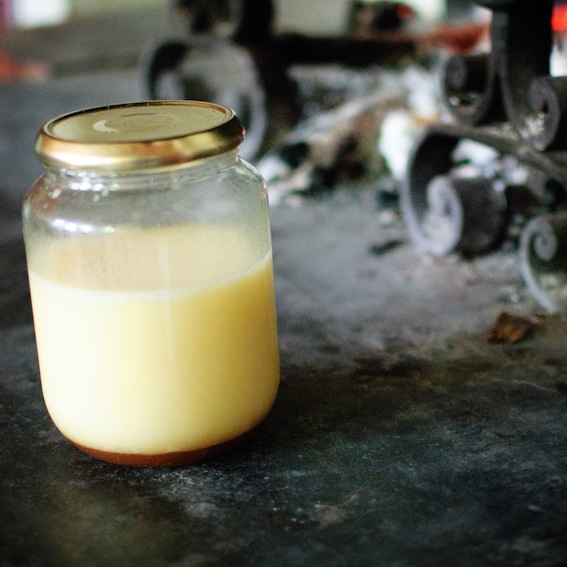-
Easy crab pâté and independence for bairns
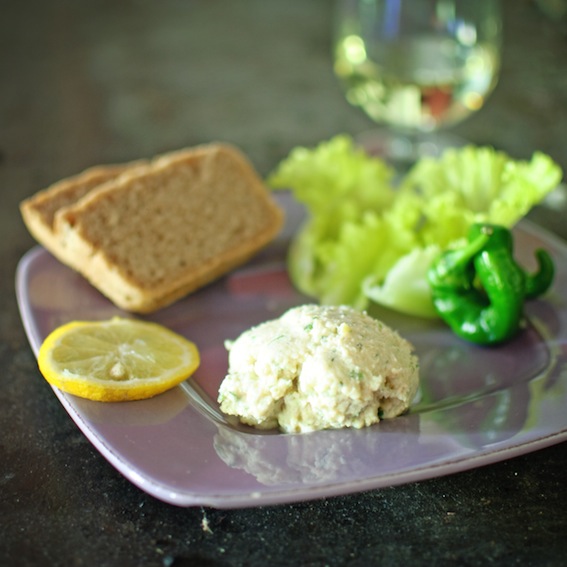
Somewhat symbolically, on the day of the Scottish independence referendum, without so much as a by your leave, little turtle dove reclaimed her freedom. With an elegant and meticulously coordinated flap of her tiny, delicate wings, her bid for independence was successfully completed in under 20 seconds. Poor Alex Salmond’s rowdy, slightly blundering flapping has failed to achieve as much in years! She seemed to know exactly where she was going too: She headed straight for a mid-section branch of the tree where the local turtle dove community hangs out in the evening. I have a suspicion that she’d be planning this mission for a while as she’d been paying close attention to the comings and goings in the tree for the past few evenings. I like to think she was greeted with open wings – there was certainly a crescendo of chirping upon her arrival. In any case, she didn’t come back for the couscous that I had left out in a bowl on the terrace last night just in case. Turtle Dove: 1, Alex Salmond: 0.
Ingredients (serves 6)
400g white crabmeat (I used tinned, in which case make sure it is well drained)
2 tablespoons of Greek Yoghurt
20g butter, melted
1 clove garlic, peeled
2 tablespoons of horseradish
Juice of 1 lemon
1 fresh chilli pepper
1 teaspoons of paprika
Sea salt and freshly ground black pepper
Combine all the ingredients in a food processor until smooth. Chill for at least two hours and serve with either bread or raw vegetables (carrots, celery, fennel…) and a slice of lemon. -
Lamb, fresh fig and almond tagine and fledgling couscous enthusiasts
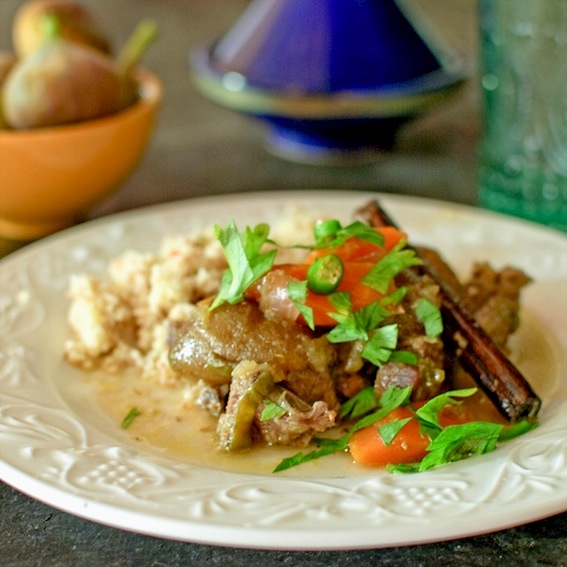
We have a young turtle dove in temporary residence at the moment. At least I think it’s temporary. Léo found her nestling in a hole at the bottom of an oak tree and brought her into the house, claiming that she’d fallen from the nest and didn’t know how to fly. He then went on to explain that the hens are ‘blood-thirsty and vicious she-devils’ and Hugo is an ‘irresponsible nutter’ and that she couldn’t possibly be left to fend for herself. In the face of this irrefutable logic, how could I refuse? At first Léo had to feed her himself, but after about a week she learned to peck and developed an absolute passion for couscous seasoned with Ras el Hanout. A neighbour told us that there are lots of Moroccan turtle doves that have settled in the area, which would explain her exotic tastes. This recipe is the result of my searches for ‘things to serve with couscous’ because, gorgeous as she is, I draw the line at cooking separate dishes for a month-old bird. Léo is coaching her in her valiant efforts to fly, and she now executes perfect sorties from her box to the water jug and back (photo below). And she’s apparently a lot more fun than toy helicopters because you ‘don’t have to recharge her batteries’. The jury’s still out though as to which is harder work; you don’t have to clear up helicopter mess innumerable times a day… I’m not altogether convinced that her plan is to put her flying skills to the ultimate test and up and leave, as I suspect she’ll have a bit of a hard time finding Ras el Hanout-flavoured couscous in the forest around here.
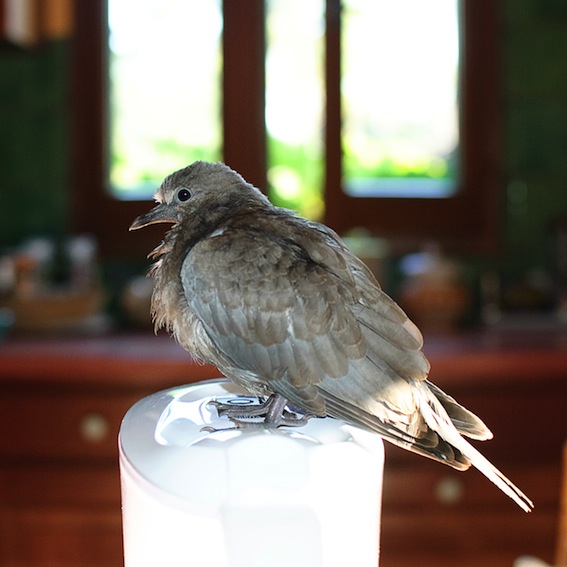
Ingredients (serves 4)
85g almonds
1kg lamb, cut into 3cm cubes
2 tablespoons olive oil
2 medium onions, finely sliced
2 cloves of garlic, crushed
3 carrots, peeled and cut into thumb-size pieces
sea salt and freshly ground black pepper
1 tablespoon freshly grated ginger
1 cinnamon stick
1 tablespoon cumin seeds
2 teaspoons ground paprika
I teaspoon turmeric
1/2 teaspoon saffron threads
2 tablespoons honey
6 fresh figs, cut in half
Fresh coriander, chopped, to serve
Toast the almonds for about 15 minutes in a small frying pan. Chop and set aside. In a medium-sized tagine or covered casserole dish (dutch oven), combine the lamb, olive oil, onions, garlic, carrots and spices, tossing well to combine. Add two cups of water, cover and gently simmer for an hour. Add the honey and figs and simmer for a further 30 minutes, checking from time-to-time that there is still some liquid (add more water if necessary). The tagine is ready once the lamb is tender and most of the liquid has evaporated. Sprinkle with almonds and coriander and serve with couscous or rice (couscous is you have an epicurean turtle dove at the table). -
Salmon with red onion, figs and honey and persecution by toothbrush

I have become victim to relentless persecution by small electronic devices. I was awoken at 4am yesterday morning by the fire alarm helpfully informing me: ‘ba-tt-er-y lowwww, ba-tt-er-y lowwww, please replace the ba-tt-er-y’ (and repeat). After three years’ blissfully silent cooperation, could the battery not have waited another couple of hours? Try finding batteries while you’re half asleep and can’t turn on the lights for fear of waking everyone up and also being attacked by unusually pugnacious mosquitos. This morning, Léo’s electric toothbrush sprung into vigorous and totally unsolicited action at 5am. It vibrated itself off the edge of the sink only to jaunt across the tiled floor towards the bedroom; pure evil (at such an antisocial hour) and hyperactive to boot. I lay in bed fuming, planning ever-spriralling retribution (leaving it to rot in a large glass of substandard cola, tearing out its bristles one-by-one, throwing it against the wall…) while it gained ground. I ended up having to go outside to dispose of it in a dustbin in the grange because it just wouldn’t pipe down. How mad is that? Resorting to moonlit dustbin visits because a toothbrush has got the better of you. And as if alarm and toothbrush angst aren’t enough, my ipad spent the day randomly blurting music from the ’70s. I think I’m going to have to apply myself to that problem though because I’m not throwing my ipad in the bin.

Ingredients (serves 4)
1 tablespoon olive oil
4 salmon filets (about 180g each)
1 small red onion, finely sliced
I chilli pepper, sliced (optional)
1 teaspoon Worcestershire sauce
Sea salt and freshly ground black pepper
4 fresh figs, sliced
1 tablespoon honey
Preheat the oven to 200°C. Drizzle the olive oil into a shallow baking dish, coating the salmon on both sides and place the filets skin side down in the dish. Add the sliced red onion, chilli pepper and Worcestershire sauce and season to taste. Finally place the sliced figs over the filets and spoon the honey over the top. Cook for 12 minutes, or until the salmon is cooked in the middle. Delicious served with perhaps green beans or a salad, but definitely with all small electronic devices in the ‘off’ position. -
Ode to a pea
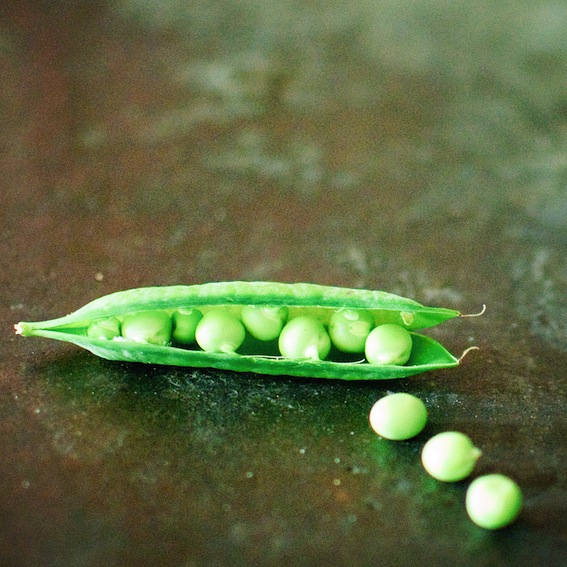
I eat my peas with honey;I’ve done it all my life.
It makes the peas taste funny,
But it keeps them on the knife.
Anon.
Hugo doesn’t like peas one little bit. In fact, he has a very finely-tuned pea radar in case they have the vulgar indecency to end up in his bowl. Once detected, he takes them in his mouth and spits them onto the floor with OCD-style assiduousness and much disdain. More fool Hugo because the unpresuming garden pea is in fact an exceedingly rich source of nutrition: Just one serving contains as much vitamin C as two apples, more thiamine than a pint of milk and at least half of your daily needs of vitamin K.
Green peas are a member of the legume family and, as such, are a rich and excellent source of protein. They are also particularly high in folic acid as well as other essential B-complex vitamins such as pantothenic acid, niacin, thiamin, and pyridoxine. They also contain many minerals – calcium, magnesium, iron, copper, zinc and manganese.
The antioxidants to be found in peas help reduce free radical damage, which in turn slows down the ageing process. Added to this, their anti-inflammatory agents (including Omega 3 in the form of alpha-linolenic acid) keep your body healthy and reduce the risk of cancer, heart disease and diabetes (type 2). Their low glycemic index makes them a good insulin-stabiliser.
Lastly, they contain a compound called genistein which has significant cancer-fighting properties and an effective anti-coagulant action, aiding in the prevention of heart attacks and strokes.
So now I’ve convinced you that you can’t live without them, how best to consume these little gems? Peas are so versatile that they may be mushed, mashed, puréed, added to soups, pestos, risottos, pasta dishes, salads and muffins. They make a tasty addition to casserole or curry dishes or eaten as an accompanying vegetable seasoned with a few leaves of fresh mint. The less water you use when cooking peas, the less vitamin C is lost; steaming helps to conserve the vitamins. Just don’t bother cooking an extra portion for your dog – it’s highly unlikely he’ll ever appreciate them! -
Sea bass in oatmeal with courgette and anchovy purée

Fishmongers in France are always keen to advise on inventive ways to prepare their produce. My favourite one writes his recipes down for me, correctly assuming that I’m only half listening and will never remember unless he does. This morning he was absent and when I asked his replacement for suggestions on how to cook sea bass, she curtly replied that I could ‘fry it, braise it, BBQ it, steam it, grill it or bake it.’ Her jaded gallic shrug after this exhaustive list seemed to imply that her final unspoken suggestion might be that I should ‘stick it’. Who knew sea bass was so versatile?
However prepared, sea bass is delicious and an abundant source of omega 3 fatty acids, iron, vitamins and minerals.
Ingredients (serves 4)
750g sea bass
1 egg, beaten
150g rolled oats (oat flakes)
20g butter
2 courgettes, peeled and sliced
1 medium-sized potato
10g parmesan cheese, grated
4 anchovies
sea salt, ground black pepper, Espelette pepper
8 black olives, chopped
olive oil
1 clove garlic, crushed
1 sprig of thyme
4 slices of lemon
Coat the fish with the beaten egg and then cover with rolled oats and set aside. Boil the potato and courgettes, drain well and purée. Add the grated cheese, anchovies, seasoning, black olives, olive oil and garlic and mix well over a very gentle heat for a few minutes or until the cheese is melted.
Melt the butter in a large frying pan with a sprig of thyme. Shallow fry the fish for about five minutes on each side and serve with the warm purée and a slice of lemon.
-
Cabbage and blue cheese mini quiches and human straitjackets
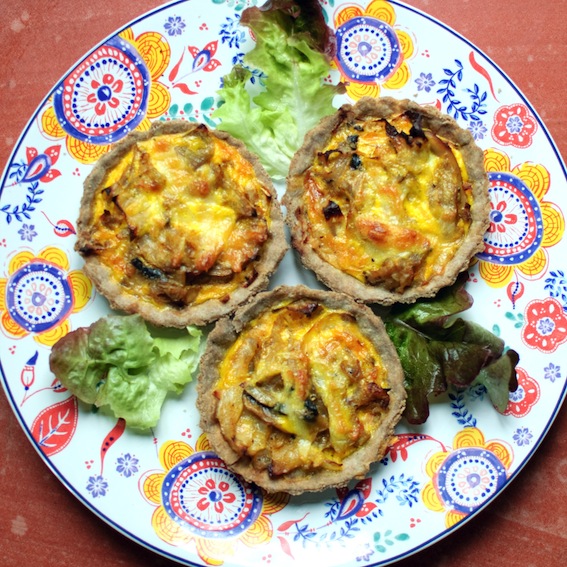
Unsurprisingly, Hugo’s annual visit to the vet is not something I particularly look forward to. I wouldn’t wish to shame my faithful friend (especially in view of our slightly volatile working relationship), but I suspect the vet might share my feelings. In a nutshell (nut being the operative word), during his last visit, he took out a cat, threw himself at a plasterboard wall leaving a significant hole and broke a table leg. He also refused to lie on the floor, preferring instead to avail himself of the chairs. I can’t even blame his appalling behaviour on white coat hypertension – the vet is always rewarded with huge, slobbery kisses for her courageous attempts to calm and vaccinate him (from Hugo, not me). I think it’s a simple case of overexcitement at the idea of being in an enclosed space with so much potential chase fodder. This time, as it was impossible to hold him on his lead (his brute force would be a match for a prize bull), bad mother and even worse pet owner that I am, I resorted to using Léo as a human straitjacket. It wasn’t ideal (I had to haul them both out from under the reception desk), but at least there was no structural damage to the surgery, which can only be a good thing. I do realise that I’m setting the bar pretty low in terms of canine obedience, but everyone has to start somewhere. In our case that appears to be rock bottom.
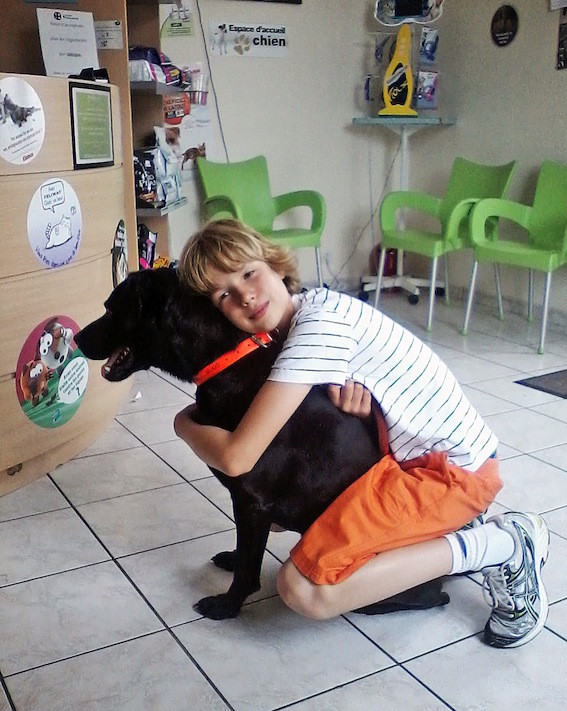
White cabbage and blue cheese complement each other beautifully. Cabbage has the highest amount of some of the most powerful antioxidants found in cruciferous vegetables, which stimulate detoxifying enzymes. It is rich in vitamin K, which is important for bone metabolism and for preventing neuronal damage in the brain. Cabbage is also an excellent source of fibre, vitamin C and the B vitamins and also provides iron, manganese, magnesium, phosphorus, calcium and potassium.
Ingredients (serves 6-8)
Pastry:
100g spelt flour
80g buckwheat flour
60g butter
30g virgin coconut oil
Roughly 6 tablespoons of cold water
Filling:
250g washed and shredded white cabbage
1 chicken or vegetable stock cube
2 shallots, sliced
Sea salt and freshly ground black pepper
1/2 teaspoon paprika
1 egg
150 ml double cream
100mg blue cheese (I used Roquefort), crumbled
To make the pastry, begin by cutting the butter and coconut oil into small cubes. Add to the flours in a mixing bowl and add a pinch of sea salt. Blend by hand until the mixture becomes crumbly. Add the cold water, mixing rapidly with a spoon. Remove the mixture from the bowl onto a lightly floured surface. Knead until you obtain a ball of pastry (if the mixture isn’t ‘sticky’ enough to form a ball, you may need a drop more water). Wrap in a clean cotton tea towel and leave to ‘rest’ in the fridge for about two hours. This relaxes the dough and makes it easier to use.
Preheat the oven to 180°C. Roll out the pastry on a clean, lightly floured surface and fill the tart tin or tins. As this pastry contains buckwheat flour, which contains no gluten, it will be quite fragile. You’ll find that you have to treat it delicately and possibly fill in the cracks with remaining bits of pastry by pressing gently. I use individual tart tins. Precook the pastry for 12 minutes.
For the filling, cook the shredded cabbage for about 15 minutes in boiling water, to which you have added the stock cube. Once cooked, drain well and set aside. Break the egg into a small bowl and add the cream and seasoning (salt, pepper, paprika). Beat well to form a homogenous mixture. Assemble the tarts by filling about ¾ full with cabbage, covering with crumbled blue cheese and then pouring the egg/cream mixture over the top. Cook at 180°C for 18 minutes. -
The perfect chip and a proxy papa
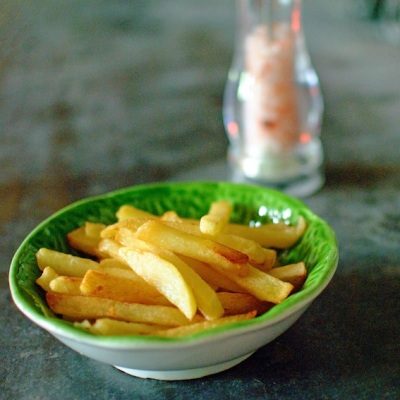
As the idea of me in charge of a vat of boiling duck fat is too harrowing to contemplate, my husband makes the chips in our house. I’m happy to report that my competence does however run to eating them. My husband is away for a few days this week and, last night, Hugo pussyfooted (sorry Hugo – I know that’s not very flattering) upstairs to Léo’s room to dispense a big slobbery goodnight kiss. He has never done this before and probably won’t do it again as, having woken Léo up, he got very short shrift (there was a burst of shouting and Hugo reappeared downstairs looking decidedly dejected, his tail between his legs). I realised that he obviously considers himself to be a stand-in papa, so now I’m wondering if he could bring the wood in for the hot-water boiler, take out the dustbins and then make me a big bowl of chips…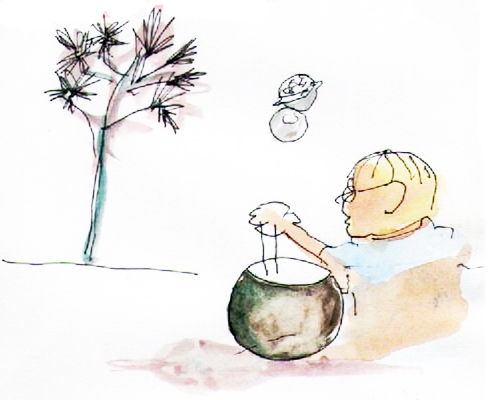
Chips, or French fries, cooked in duck fat are a speciality of Southwestern France. Duck fat is high in monounsaturated fats, which make up 50 percent of its total fat content, with saturated fat making up just 14 percent (much less than butter). Most of that fat is linoleic acid, an essential fatty acid that helps maintain healthy cells, muscles and nervous system. It also boosts calcium absorption and aids in kidney function. From a nutritional point of view, duck fat is comparable to olive oil.
Ingredients (serves 6)
2 kg floury potatoes
2 litres duck or goose fat
Sea salt
Peel the potatoes and cut into medium-sized chips (roughly 6cm long, 4mm thick). Rince and dry in a clean tea towel. Place the fat in a deep frying or chip pan and heat to 150°C. Plunge half of the potatoes into the hot fat for four minutes, remove, drain and set aside. Repeat with the second half. Then recook the first batch for a further four minutes until golden brown. Remove, drain well, season and serve. Repeat with the second half. -
Pea and mint soup and Hugo’s new byline

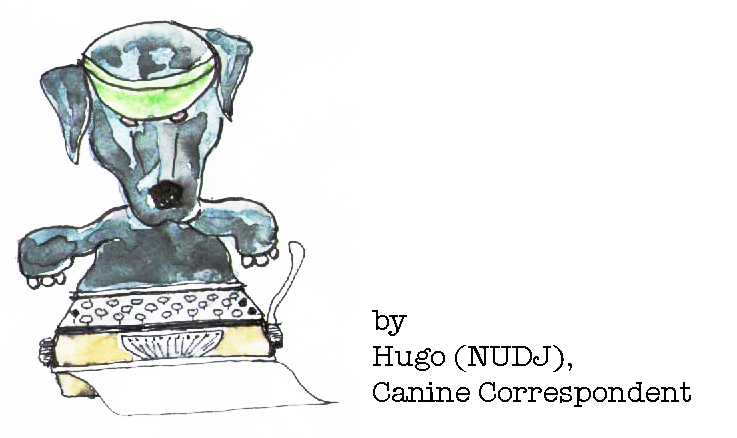
I recently joined the NUDJ (National Union of Dog Journalists) because Bossy can be inclined to take advantage of my good nature. I also decided that I needed a proper byline and my favourite artist submitted a few pwoofs that you can see above and below. I quite like them, although I do wonder whether they properly portray the fact that I am a sophisticated dog of great intellectual gravitas… I would appreciate your opinions.
I’ve been rushed off my paws even more than usual this week; we are in the throes of a baby deer boom. These baby deer have no sense of territory or propriety, which is quite exhausting. And as if this isn’t taxing enough, a family of ducks has moved in without so much as a by-your-leave. They quack very loudly all night and stop me from sleeping. As I work until at least midnight every night, I need all the rest I can get *bone-tired doggie sigh*. When I get time, I shall write to my union about all this noise and overtime.
To be honest, this pea soup is as dull as ditchwater. I’ve never been keen on green-coloured food because, in my world, green means that it’s gone bad. Still, they all seemed to like it, although the Noisy One appears to share my suspicion of anything green.

I’m sorry this soup doesn’t meet with your approval Hugo, although, as this is a healthy eating blog, you might want to dilute your opinion on green things a little bit for next time? I thought it was a particularly delicious Spring soup and will certainly make it again. Peas are sometimes referred to as ‘nature’s multivitamin’, as they contain no fewer than eight vitamins and seven minerals. They are also a good source of fibre and protein and lower the overall glycemic index of any dish to which they are added.
This soup is adapted from a recipe in Anthony Worrall Thompson’s excellent book, ‘GI Diet’.
Ingredients (serves 4 – 6)
10g salted butter
1 tablespoon olive oil
1 onion, peeled and chopped
2 leeks, washed and chopped
1 garlic clove, finely chopped
275g peas, fresh or frozen
1 large courgette, washed and chopped
1 litre chicken or vegetable stock
Sea salt and freshly ground black pepper
1 teaspoon paprika
1 tablespoon fresh mint, finely chopped
Melt the butter in a large saucepan with the olive oil. Add the onion, leeks and garlic and gently soften. Add the peas, courgette and stock and bring to the boil. Add the seasoning and cook until the peas and courgette are tender (about 20 minutes). Add the mint and purée until smooth. -
Courgette, cheese and chickpea cake (gf)
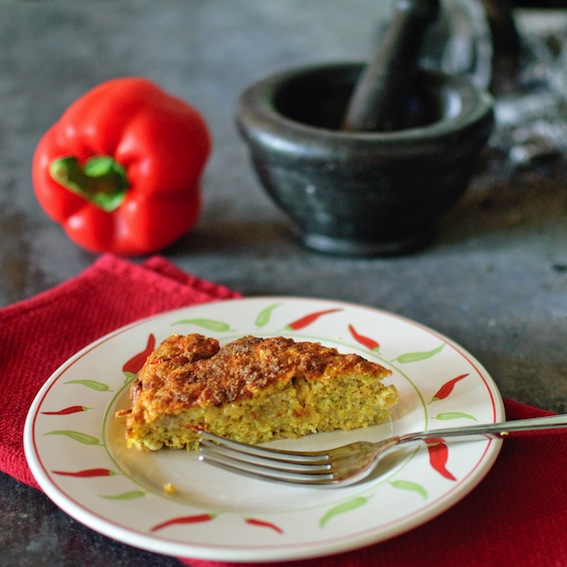
As a follow-on to my previous recipe, I thought I would try a savoury version of the chickpea cake. The result was a protein-rich cross between a paschtida and a savoury flan or cake. In any case, it was very tasty and would make an ideal accompaniment (we ate it with spicy sausages), or could be served on its own with a green salad. This recipe is particularly for Jenna, who is currently in need of quick and easy-to-make gluten-free sustenance.Ingredients (serves 6)
300g chickpeas (garbanzo beans), pre-cooked and rinsed (you can use tinned)
4 eggs, beaten
1 courgette, peeled and finely chopped
½ red pepper, washed and sliced
1 shallot or small onion, peeled and sliced
1 teaspoon bicarbonate of soda
sea salt and freshly-ground black pepper
2 teaspoons paprika
150g hard cheese (I used Comté), grated
Preheat the oven to 160°C. Grease and prepare a medium-sized cake tin, round or square. Pulse the chickpeas in a food processor until they reach a paste-like consistency and then mix in the other ingredients, except the cheese, one at a time, continuing to pulse. Add the cheese last and mix in by hand. Pour the mixture into the cake tin and bake for an hour (a fork inserted into the centre should come out clean). May be served hot or cold.
-
Spelt pilaf and painful toes

Yesterday, when Castaño, our Exceedingly Naughty Horse, stood heavily on my little toe, I thought my husband’s reaction, ‘don’t worry, it can’t possibly be broken – he’s not very heavy’ (translated: ‘stop moaning and get over it’), could have been a little more sympathetic. I don’t know what his point of reference is, but half a ton of gyrating horse on my little toe certainly felt heavy to me.
Today, while treating our mare’s foot (she managed to stand on the only piece of stray metal within a ten kilometre radius), Luc had his toe stamped on. Castaño, in full-blown ‘joys of Spring’ mode, saw fit to bite the mare’s rear end while she was tied up and, in reaction to the whippersnapper’s blatant audacity, she lashed out behind and stood on Luc’s toe in front. When he yelled at me to get my ‘damned Iberian hooligan’ out of the way, my innate sense of decorum prevented me from saying: ‘it can’t have hurt that much, she’s not very heavy’. Or it almost did anyway. 😉

Spelt grain has a robust, slightly nutty flavour and is high in fibre, B vitamins and minerals. It also contains all nine amino acids. Another considerable benefit of spelt is that it is less likely to cause allergy or intolerance than wheat.
Ingredients (serves 4)
1 tablespoon olive oil
2 shallots, peeled and chopped
2 cloves of garlic, peeled and chopped
200g spelt grain
1 tomato, peeled and cubed
sea salt and freshly ground black pepper
I teaspoon curry powder
750ml chicken or vegetable stock
20g cashew nuts
fresh parsley or basil
Gently fry the shallots and garlic in olive oil in a large frying pan until softened. Add the spelt grain and continue to fry for a few minutes, mixing well so that the grain is covered in olive oil. Add the tomato, stock and seasoning, again mixing well. Leave to simmer for about 30 minutes until the spelt is cooked, stirring from time to time to prevent sticking. Stir in the cashew nuts a few minutes before the end of cooking time and add the parsley or basil to garnish before serving.
